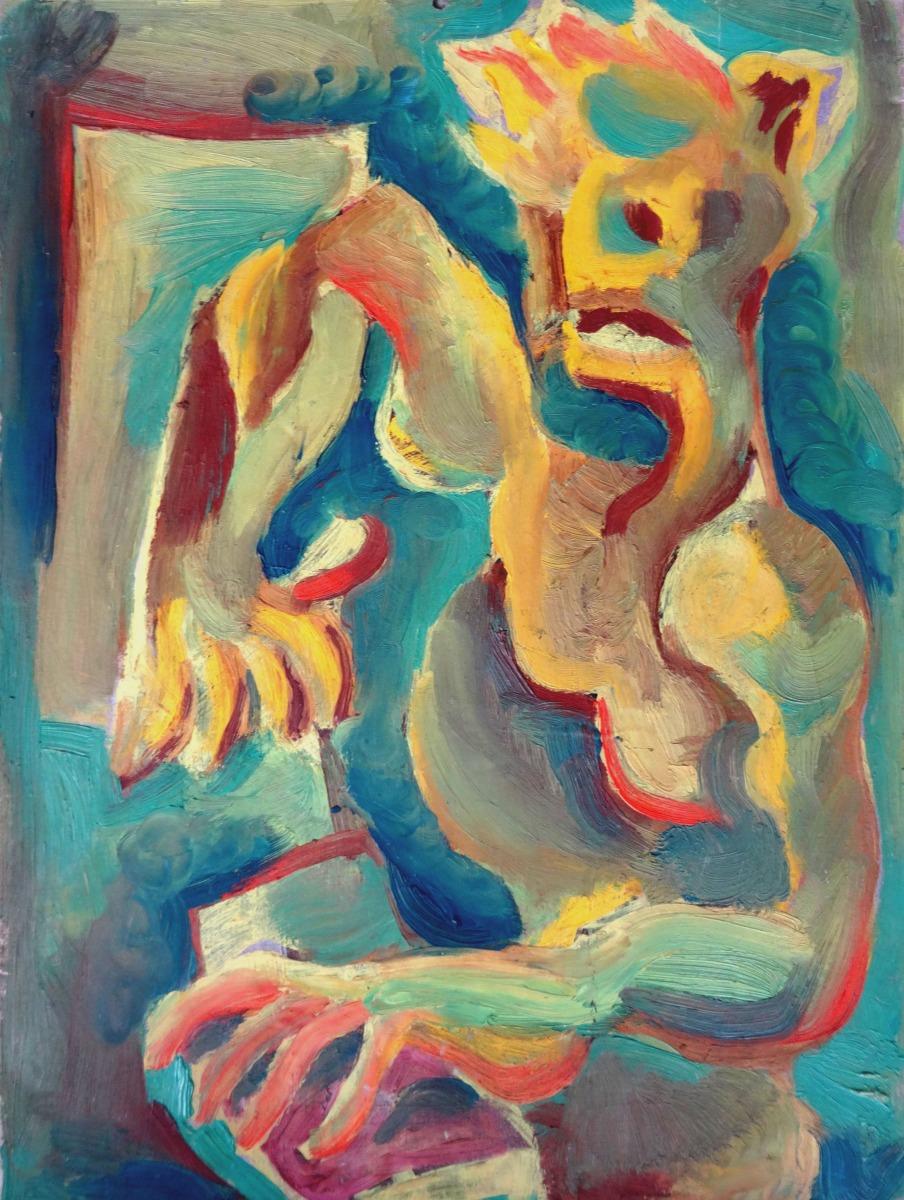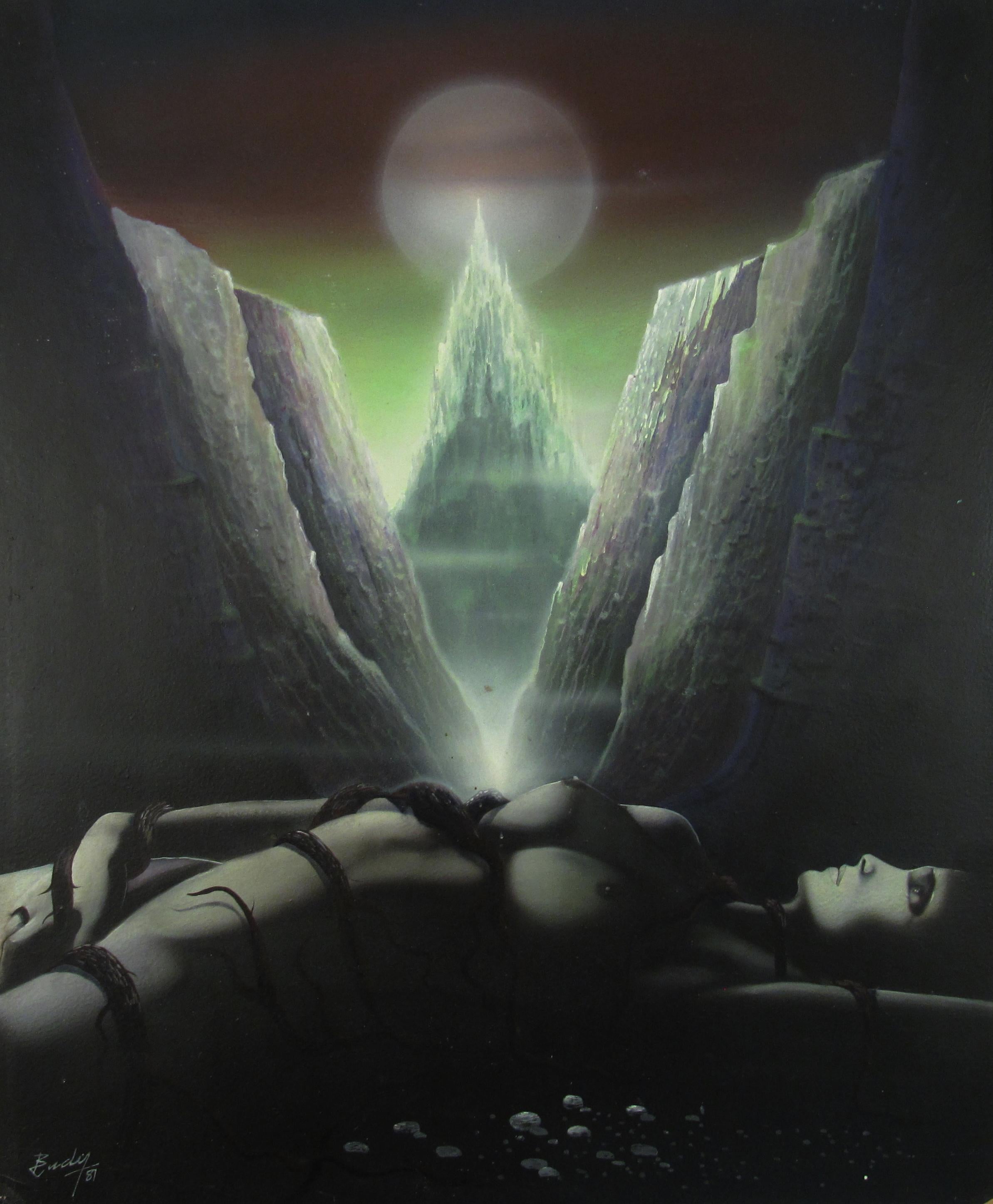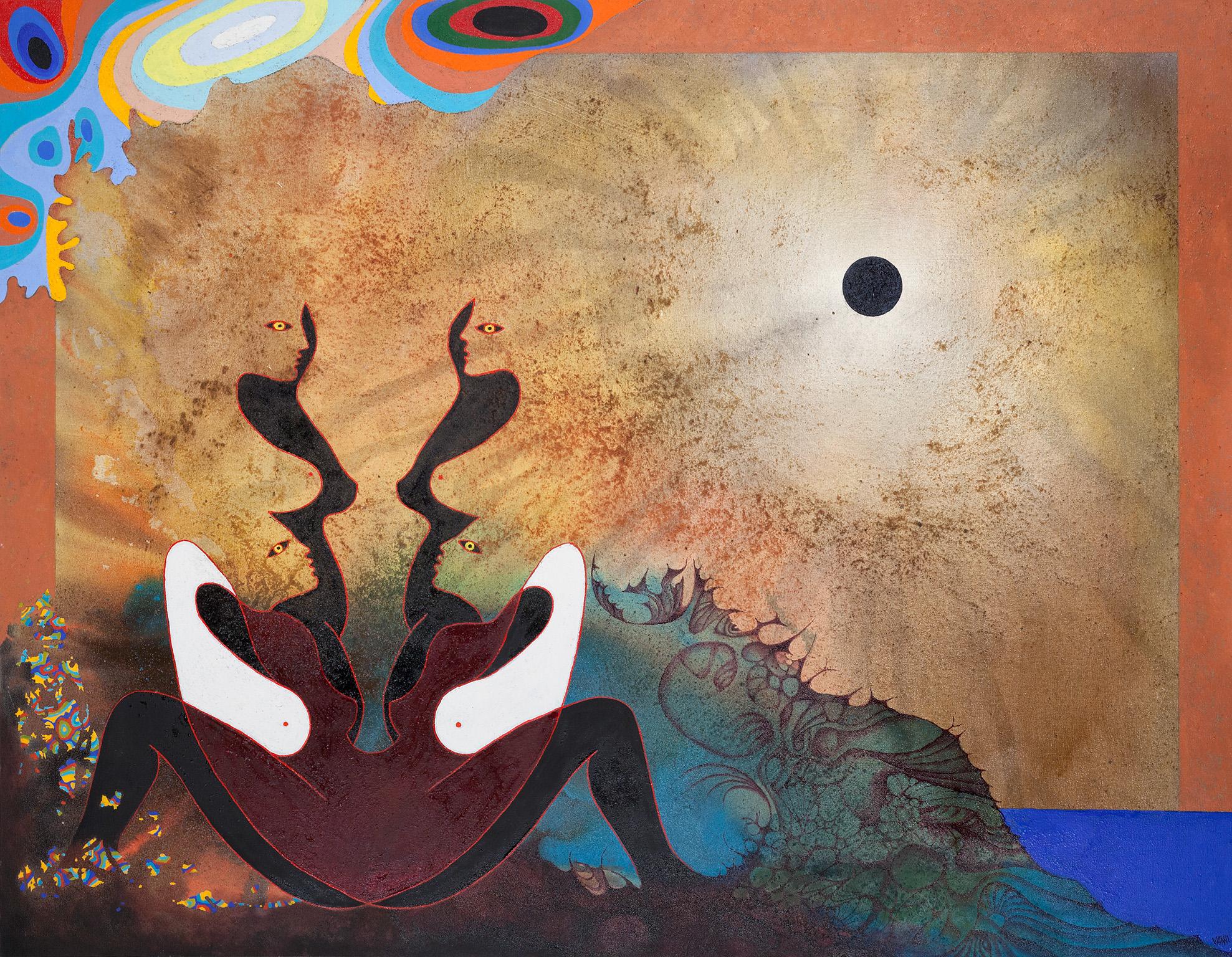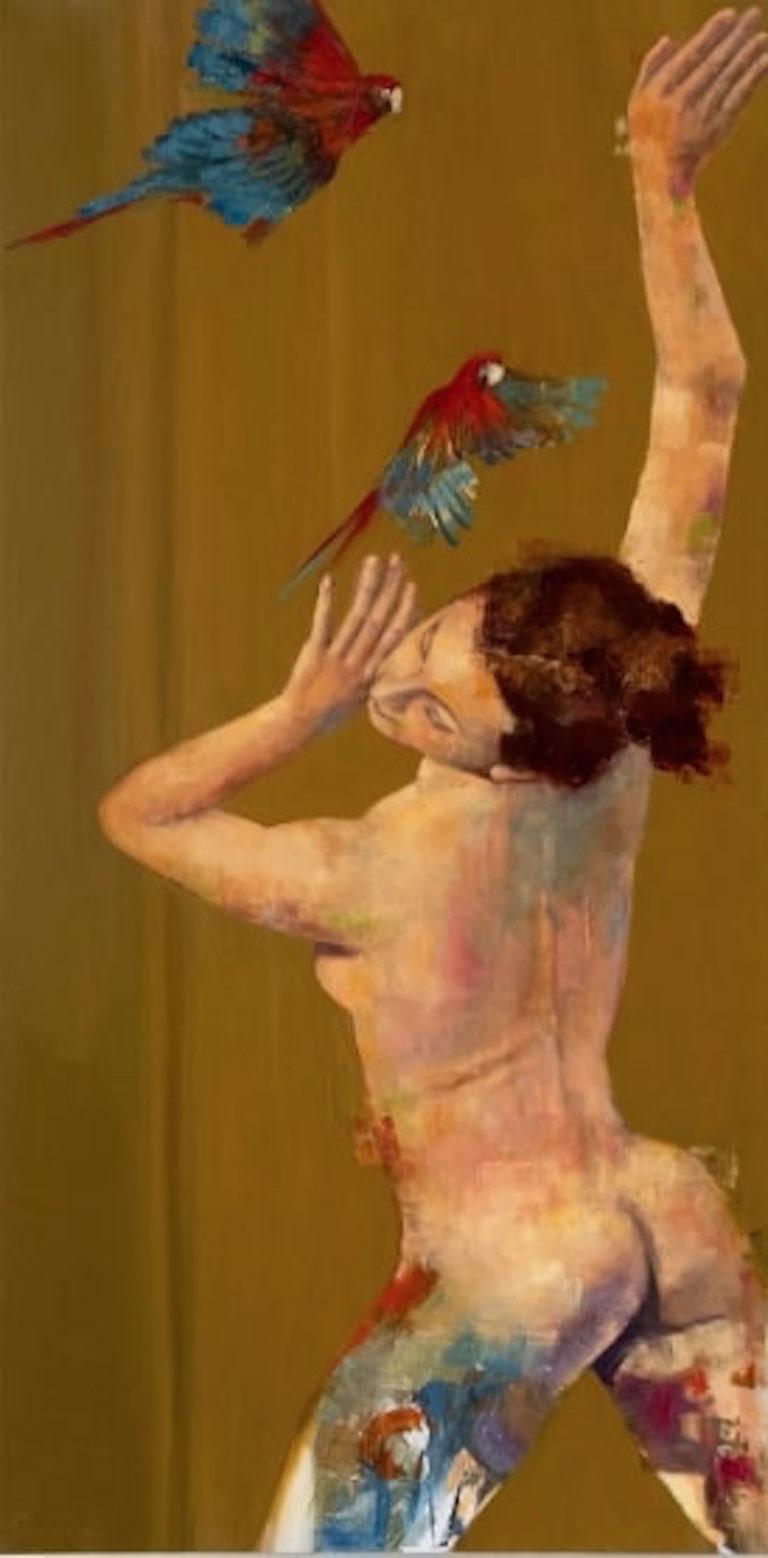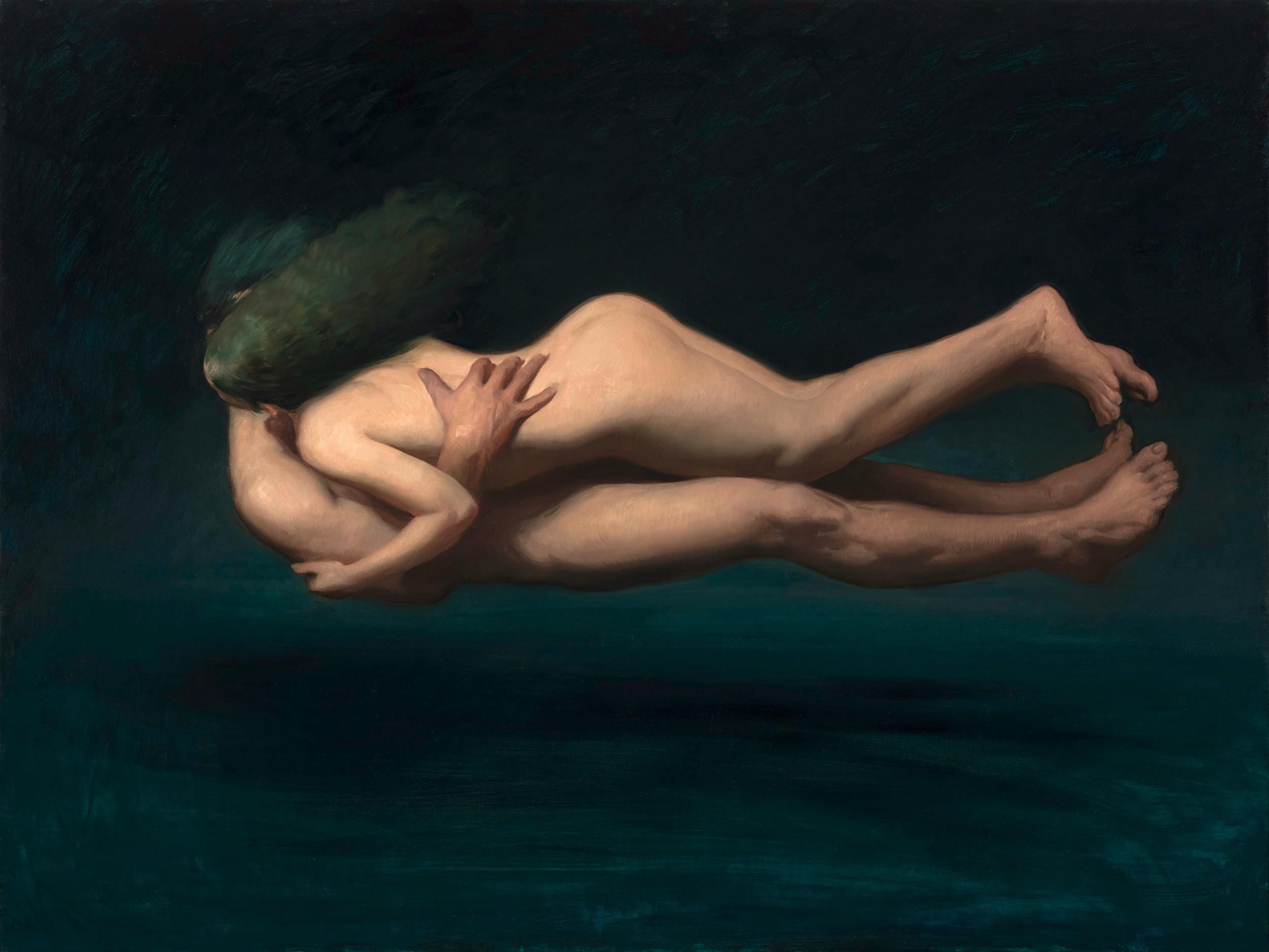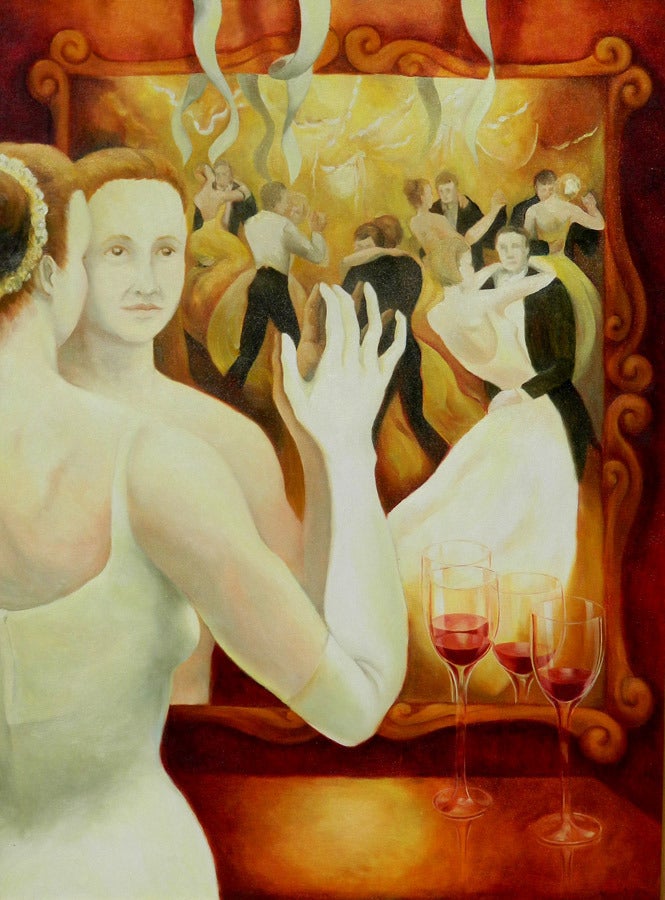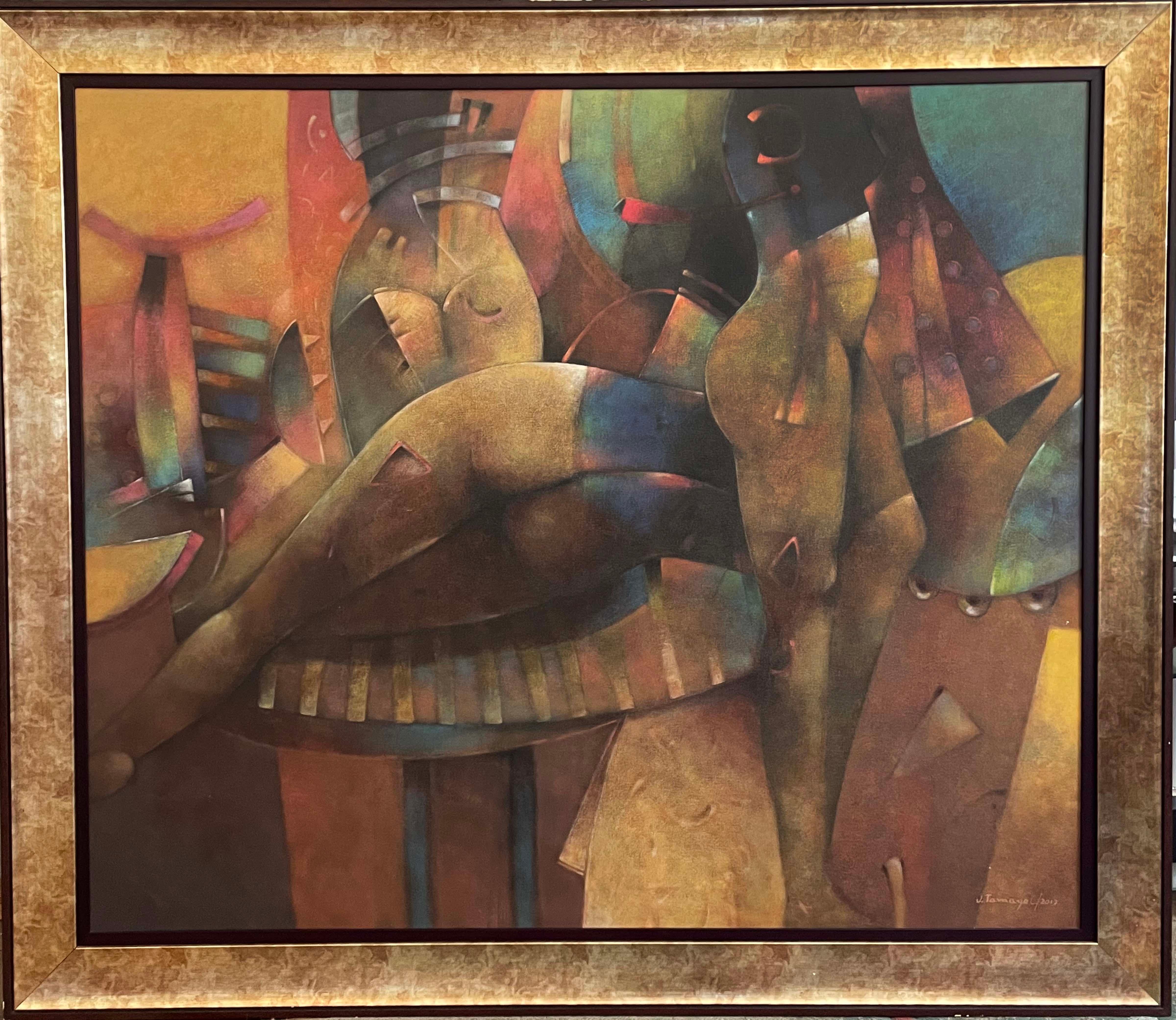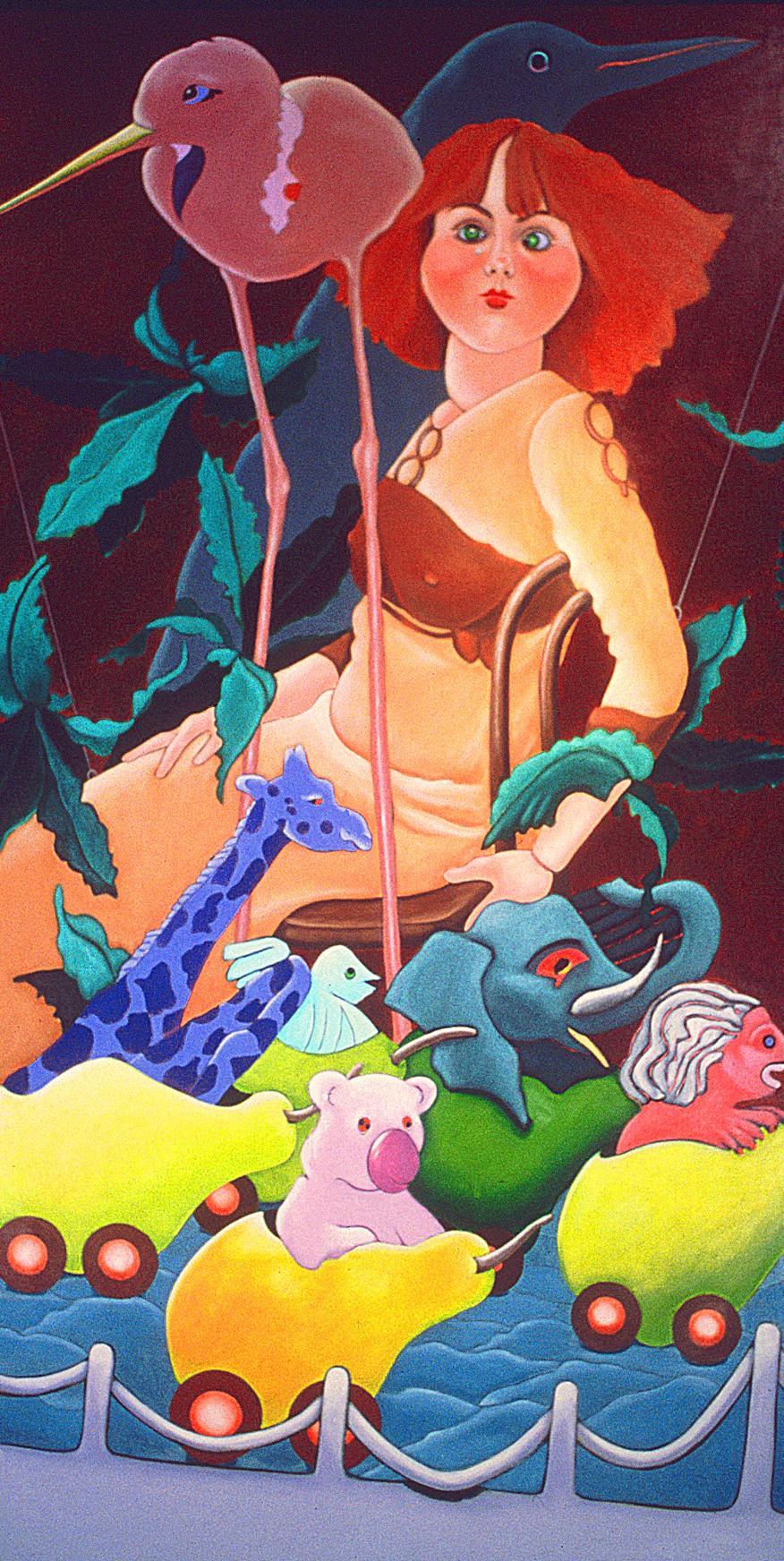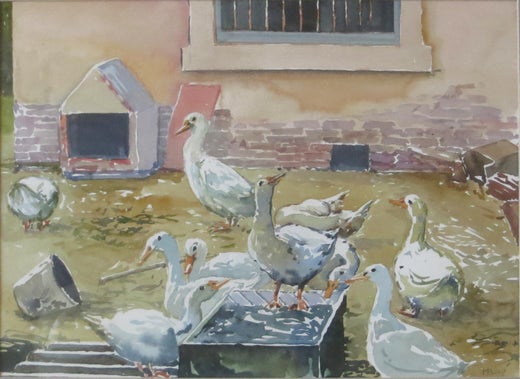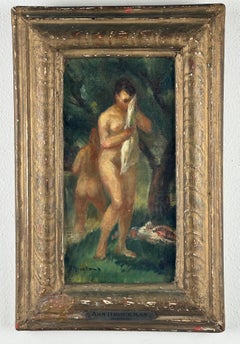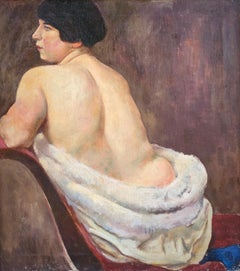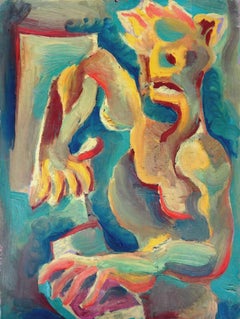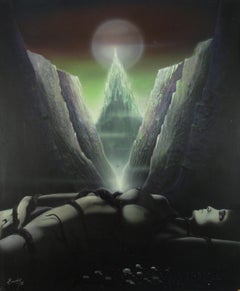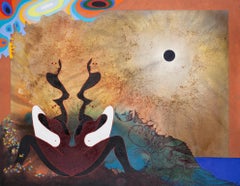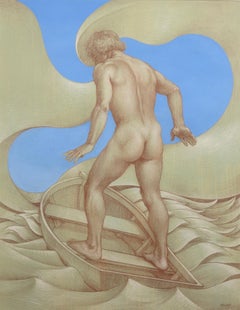
Study for Rocking the Boat (male nude)
View Similar Items
Want more images or videos?
Request additional images or videos from the seller
1 of 11
Michael BergtStudy for Rocking the Boat (male nude)1999
1999
About the Item
- Creator:Michael Bergt (1956, American)
- Creation Year:1999
- Dimensions:Height: 24 in (60.96 cm)Width: 18 in (45.72 cm)Depth: 1 in (2.54 cm)
- Medium:
- Movement & Style:
- Period:
- Condition:
- Gallery Location:Wilton Manors, FL
- Reference Number:1stDibs: LU24523402113
Michael Bergt
Michael Bergt is an internationally recognized figurative artist known for his mastery of a variety of media, from his renowned egg tempera paintings and pencil drawings to bronze sculpture. Ambiguity is a central tenent in his process and allows for reflection on the paradoxes of the human condition. Using diverse sources of visual cultures from the East to the West, Bergt’s work unites the two major themes of figurative art, the sensual and the spiritual into works of delicate mastery. Michael Bergt has received numerous international awards, including one of his works being featured in the 2018 BP Portrait Award, the most prestigious painting competition in the world, at the National Portrait Gallery in London, as well as one of his works being selected for the “out of the box” category in the 2020 National Portrait Society of America competition. Bergt has shown his work nationally and internationally for over forty years in numerous solo and group museum exhibitions including the Arnot Museum, Elmira, New York; Belvedere Place, Vienna, Austria; Center for Contemporary Arts, Santa Fe, New Mexico; de Young Museum, San Francisco, California; the Frye Art Museum, Seattle, Washinging; The Evansville Museum of Arts and Sciences, Evansville, Indiana; and Kalamazoo Institute of Art, Kalamazoo, Michigan. Michael Bergt’s paintings and sculptures have been featured in a multitude of publications, and have won numerous awards both domestically and abroad. His work is held in countless public and private collections, among them the: Fons D’Art del Diari Avui, Barcelona, Spain; de Young Museum, San Francisco, California; Arnot Art Museum in Elmira, New York; Frye Art Museum, Seattle, Washington; The Museum of New Mexico, Santa Fe, New Mexico; Crystal Bridges Museum of American Art, Bentonville, Arkansas; and California Palace of the Legion of Honor; San Francisco, California.
About the Seller
4.9
Platinum Seller
These expertly vetted sellers are 1stDibs' most experienced sellers and are rated highest by our customers.
Established in 2007
1stDibs seller since 2015
330 sales on 1stDibs
Typical response time: 1 hour
More From This SellerView All
- Female Bather (Nude Women)Located in Wilton Manors, FLAnn Brockman (1895–1943) was an American artist who achieved success as a figurative painter following a successful career as an illustrator. Born in California, she spent her childhood in the American Far West and, upon marrying the artist William C. McNulty, relocated to Manhattan at the age of 18 in 1914. She took classes at the Art Students League where her teachers included two realist artists of the Ashcan School, George Luks and John Sloan. Her career as an illustrator began in 1919 with cover art for four issues of a fiction monthly called Live Stories. She continued providing cover art and illustrations for popular magazines and books until 1930 when she transitioned from illustrator to professional artist. From that year until her death in 1943, she took part regularly in group and solo exhibitions, receiving a growing amount of critical recognition and praise. In 1939 she told an interviewer that making money as an illustrator was so easy that it "almost spoiled [her] chances of ever being an artist."[1] In reviewing a solo exhibition of her work in 1939, the artist and critic A.Z Kruse wrote: "She paints and composes with a thorough understanding of form and without the slightest hesitancy about anatomical structure. Add to this a magnificent sense of proportion, and impeccable feeling for color and an unmistakable knowledge of what it takes to balance the elements of good pictorial composition and you have a typical Ann Brockman canvas."[2] Early life and training Brockman was born in Northern California in 1895 and spent much of her youth in nearby Oregon, Washington, and Utah.[1][3] She met the artist William C. McNulty in Seattle where he was employed as an editorial cartoonist. They married in March 1914 and promptly moved to Manhattan where he worked as a freelance illustrator.[4][5] At the time of their marriage, Brockman was 18 years old.[6] Over the next few years, her career generally followed that path that her husband had previously taken. His art training had been at the Art Students League beginning in 1908; she began her training there after moving to New York in 1914.[1] After an early career as an editorial cartoonist, he freelanced as a magazine and book illustrator beginning in 1914; she began her career as a magazine and book illustrator in 1919.[7] He embarked on a teaching career in the early 1930s and not long after, she began giving art instruction.[8][9] While they both adhered to the realist tradition in art, their usual subjects were different. His prominently depicted urban cityscapes in the social realist whereas hers generally focused on rural landscapes. He was best known for his etchings and she for her oils and watercolors.[8][10] Brockman returned to the Art Students League in 1926 to take individual instruction for a month at a time from George Luks and John Sloan.[1] Despite their help, one critic said McNulty's "sympathetic encouragement and guidance" was more important to her development as a professional artist.[11] Career in art In the course of her career as illustrator, Brockman would sometimes paint portraits of celebrities before drawing them, as for example in 1923 when she painted the French actress Andrée Lafayette who had traveled to New York to play title role in a film called Trilby.[12] She would also sometimes accept commissions to make portrait paintings and in 1929 painted two Scottish terriers on one such commission.[13] During this time, she also produced landscapes. In 1924 she displayed a New England village street scene painting in the Second Annual Exhibition of Paintings, Watercolors, and Drawings in the J. Wanamaker Gallery of Modern Decorative Art.[14] Available sources show no further exhibitions until in 1930 a critic for the Boston Globe described one of her portraits as "well done" in a review of a Rockport Art Association exhibition held that summer.[15] Between 1931 and her death in 1943, Brockman participated in over thirty group exhibitions and five solos.[note 1] Her paintings appeared in shows of the artists' associations to which she belonged, including the Rockport Art Association, Salons of America, Society of Independent Artists, and National Association of Women Painters and Sculptors.[17][19]Between 1932 and 1935, her paintings appeared frequently in New York's Macbeth Gallery.[20][23][25][27] She won an award for a painting she showed at the Art Institute of Chicago in 1940.[41] In 1942, the Whitney Museum bought one of the paintings she showed in its Biennial of that year.[10] Critical praise for her work steadily increased during the decade that ended with her untimely death in 1943. In 1932, her painting called "The Camera Man" was called "a clever piece of illustration."[21] Three years later, a painting called "Small Town" gave a critic "the impression of freshness, honesty, and skill".[29] In 1938, a critic described her "Folly Cove" as "masterful" and said "Pigeon Hill Picnic" was "sustained by excellence of execution".[48] At that time, Howard Devree of the New York Times saw "evidence of gathering powers" in her work and wrote "she imparts a dramatic feeling to landscape. She even manages this time to do trees touched by Autumn tints without calendar effect, which is no small praise."[51] Three years later, a Times critic reported Brockman had "set herself a new high" in the watercolors she presented,[52] and another critic said the gallery where she was showing had not "for some time" shown "so outstanding a solo exhibitor as Ann Brockman."[2] Shortly before her death, a critic for Art News maintained that she was "one of America's most talented women painters".[46] After she had died, a critic said Brockman's paintings "displayed real power", adding that she was "highly rated among the nation's professional artists" and was known to give "aid and encouragement, always with a smile," both artists and to her students.[10] in reviewing the memorial exhibition at the Kraushaar Galleries held in 1945, reviewers wrote about the strength and vibrancy of her personality, the quality of her painting ("every bit as good, possibly better than people had thought"),[53] called her "one of the best of our twentieth century women painters", and credited "her sense of the vividness of life" as a contributor to "the unusual breadth that is so characteristic of her work.[11] One noted that her work was "widely recognized throughout the country" and could be found in the collections of prominent museums, including the Metropolitan Museum of Art, the Whitney Museum of American Art, and the Art Institute of Chicago.[54] Writing in the Times, Devree wrote, "even those who had followed the steady growth of this artist for more than a decade, each successive show being at once an evidence of new achievement and an augury of still better work to come, may well be surprised at the combined impact of the selected paintings in the present showing,"[55] and writing in the Brooklyn Daily Eagle, A.Z Kruse said she had made "extraorginary accomplishments", painted with "inordinate distinction" showing a "lyrical majesty," and possessed "a keen esthetic sense which did not deviate from truth."[54] Artistic style (1) Ann Brockman, undated drawing, black chalk on paper, 18 x 22 inches (2) Ann Brockman, High School Picnic, about 1935, oil on canvas, 34 1/4 x 44 1/4 inches (3) Ann Brockman, untitled landscape, about 1943, watercolor and pencil on paper, 15 1/4 x 22 1/2 inches (4) Ann Brockman, North Coast, undated watercolor, 21 1/2 x 30 inches (5) Ann Brockman, On the Beach, 1942, watercolor on paper, 16 1/2 x 20 inches (6) Ann Brockman, Lot's Wife, 1942, oil on canvas, 46 x 35 inches (7) Ann Brockman, New York Harbor, 1934, watercolor on paper, 13 1/2 x 19 1/4 inches (8) Ann Brockman, Youth, 1942, oil on board, 13 1/2 x 11 1/2 inches Brockman was a figurative painter whose main subjects were rural landscapes and small-town and coastal scenes. She worked in oils and watercolors, becoming better known for the latter late in her career. Most of her paintings were relatively small. Although she made figure pieces infrequently, the nudes and circus and Biblical scenes she painted were seen to be among her best works. In 1938, Howard Devree wrote: "Her gray-day marines and coast scenes are familiar to gallery goers and are favorites with her fellow artists. Her figure pieces have attained a sculptural quality without losing warmth or taking on stiffness. One spirited circus incident of equestriennes about to enter the big tent compares not unfavorably with many of the similar pictures by a long line of painters who have been fascinated by the theme. She imparts a dramatic feeling to landscape. She even manages this time to do trees touched by Autumn tints without calendar effect, which is no small praise."[51] Similarly, a critic for Art Digest wrote that year: "Fluently and virilely painted, [her] canvases suggest a close affinity between nature and humans. The artist takes her subjects out in the open where they may picnic or bathe with space and air about them. A fast tempo is felt in the compositions of restless horses and nimble entertainers busily alert for the coming performance. Miss Brockman is also interested in portraying frightened groups of people, hurrying to safety or standing half-clad in the lowering storm light."[56] Her palette ranged from vivid colors in bright sunlight to somber ones in the overcast skies of stormy weather. Of the former, one critic spoke of the rich colors and "sun-drenched rocks" of her coastal scenes and another of her "summery landscapes of coves and picnics."[11][50] Of the latter, Howard Devree said she "painted so many moody Maine coast vignettes of lowering skies and uneasy seas that artists have been heard to refer to an effect as 'an Ann Brockman day'".[57] Brockman's handling of Biblical subjects can be seen in the oil called "Lot's Wife", shown above, Image No. 6. Her watercolor called "On the Beach" and her oil portrait called "Youth" may both indicate the "sculptural quality" that Devree said was typical of her figure pieces (Image No. 8, above). An example of Brockman's bright palette in a typical summer theme is the oil painting called "High School Picnic" shown above, Image No. 2. Next to it is a painting, an untitled landscape of about 1943 whose medium, watercolor on paper, shows off the sunny palette she often used (Image No. 3). Among the darkest of her works was an untitled 1942 drawing she made in black chalk (shown above, Image No. 1). In a book called Drawings by American Artists (1947), the artist and art editor Norman Kent noted that this study influenced her painting through its use of "forms" that were "elastic" and suggested "color". He said its "massing of dark and light" created "a definite mood" that was "impressionistic" and had "the strength of a man's work".[58] Brockman's undated watercolor called "North Coast" (shown above, Image No. 4) is an example of the paintings to which Kent referred. Illustrator (9) Ann Brockman, cover, March 12, 1917, Every Week magazine (10) Illustration of an article, "The Taking of a Salient" by Henry Russell...Category
1930s American Impressionist Nude Paintings
MaterialsOil
- Nude WomanLocated in Wilton Manors, FLBeautiful female nude in profile. European, ca. 1920-30. Oil on canvas, 31.5 x 35.75 inches; 35.5 x 39.75 inches framed. Sign indistinctly upper right. A few areas of paint loss (v...Category
Early 20th Century Academic Nude Paintings
MaterialsOil
$1,250 Sale Price50% Off - CherubsBy George Henry HallLocated in Wilton Manors, FLGeorge Henry Hall (1825-1913). Cupids, 1875. Oil on canvas, 6 x 9.25 inches; 10 x 13.25 inches framed. Original frame with label verso. Excellent condition with no damage or restoration. Signed and dated lower right. Price on request Biography: Birth place: Manchester, NH Addresses: Primarily in NYC from 1852 Profession: Still-life, genre, portrait painter Studied: between 1849-52 in Paris and Rome; and Düsseldorf Royal Acad. with Eastman Johnson Exhibited: PAFA, 1853-68; Royal Acad., British Inst., Suffolk Street Gal., all in London, 1858-74; Brooklyn AA, 1861-81; NAD, 1862-1900; AIC, 1888; Boston AC, 1881, 1889 Member: ANA, 1853; NA, 1868; Century Assn. Work: MMA; BM; BMFA Comments: Best known for his still-lifes, he specialized in detailed and vividly colored fruit and flower...Category
19th Century Realist Figurative Paintings
MaterialsOil, Canvas
$3,000 Sale Price64% Off - Nude Figure (Nude woman)Located in Wilton Manors, FLSerge Hollerbach (1923-2021). Nude Figure, 1968. Casein on illustration board, image measures 8.5 x 11 inches; 14.5 x 17 inches in a custom Kulicke welded steel frame. Signed and dated lower margin. Painter, Instructor Born in Pushkin, Russia November 1, 1923. Education : Academy of Fine Arts in Munich; Art Students League with Ernest Fiene; American Art Scholarship with Gordon Samstag. Holdings : St. Paul Gallery...Category
Mid-20th Century Abstract Abstract Paintings
MaterialsCasein
- Untitled (Male Nude Leather Daddy)Located in Wilton Manors, FLSherman Yee. Untitled (Male Nude Leather Daddy), 2019. Watercolor on paper, 9 x 12 inches; 10 x 13 inches frame. Signed on both front and back. Sherman ...Category
2010s Abstract Nude Paintings
MaterialsWatercolor
- Mr. Jack Barrow (Male Nude)Located in Wilton Manors, FLSherman Yee. Mr. Jack Barrow, 2019. Watercolor on paper, 9 x 12 inches; 10 x 13 inches frame. Signed on both front and back. Sherman Yee is a talented a...Category
2010s Abstract Nude Paintings
MaterialsWatercolor
You May Also LikeView All
- In work/Four figures. Double-sided, cardboard, tempera, 56x47 cmBy Vladimir GlushenkovLocated in Riga, LVIn work/Four figures. Double-sided, cardboard, tempera, 56x47 cm Vladimir Borisovich Glushenkov (May 21, 1948, Riga - December 26, 2009, Riga.) - painter, graphic artist, poet, translator. Born in Riga in a Russian-Polish-German family. Vladimir Glushenkov...Category
1970s Surrealist Figurative Paintings
MaterialsMixed Media, Cardboard, Tempera
- Yves Bady AL-Dahdah (Lebanese 1941) Lady of the Vines, 1981, Surrealist PaintingLocated in Meinisberg, CHYves Bady AL-Dahdah (Lebanese, 1942) Lady of the Vines • Oil or Acrylic on heavy fibre board ca. 46 x 38 cm x 0.5 cm • Signed and dated lower left (19)81 •...Category
1980s Surrealist Figurative Paintings
MaterialsPaint, Fiberboard
- Eclipse - Painting with Female Figures and Sun EclipseBy Gian Berto VanniLocated in New York, NYEclipse is a 56 x 72-inch surrealist figurative oil painting. It is signed in the front lower right corner. The primary colors are brown and blue. Silhouettes of nude female figures ...Category
2010s Surrealist Figurative Paintings
MaterialsOil, Cotton Canvas
- Surrealist Figurative painting, "Guaracha"Located in San Diego, CAThis is a one of a kind original oil painting by San Diego artist, Julia San Roman. Its dimensions are 24" x 48". A certificate of authenticity will fo...Category
2010s Surrealist Nude Paintings
MaterialsOil
- Venus Retrieved from the Hands of Death, Surrealist, Nudes, 1959, Oil on CanvasBy Leon KellyLocated in Doylestown, PA"Venus Retrieved from the Hands of Death" by Philadelphia born modernist painter Leon Kelly, is a fantasy nude group scene of one female and two male figures. The 49" x 36" oil on ca...Category
1950s Surrealist Nude Paintings
MaterialsCanvas, Oil
$25,000 Sale Price28% OffFree Shipping - "Les deux moitiés" two figures floating through deep green and blue waterBy Daniela AstoneLocated in Sag Harbor, NY"Les deux moitiés" is a contemporary ethereal nude figures in green and blue water. Astone brought professional dancers into her studio and let them improvise as she painted them. Sh...Category
21st Century and Contemporary Surrealist Figurative Paintings
MaterialsOil, Canvas
Recently Viewed
View AllMore Ways To Browse
Male Nude 1990s
Estate Of Sultan
Mars 1 Artist
Jeanette May
Spanish Male Nudes
Life Size Male Nude Sculpture
Science Of Hitting
6 Ft Sculpture
John D Wilson
Portrait Sultan
Large Metal Floral Sculpture
Nude Men Beach
Paper Window Shades
Vintage Art Sacred Heart
Santa Anna
Nude Male Erotic Images
Painting Anna P
Vi Spring
